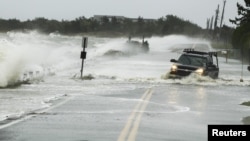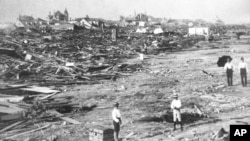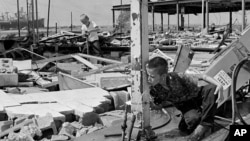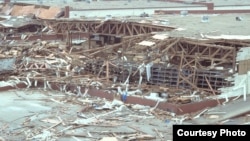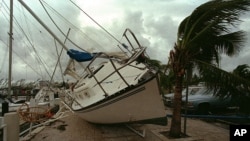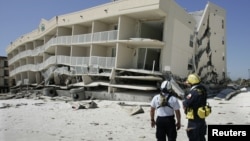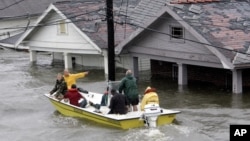The United States gets hit frequently by hurricanes or tropical storms. But some, like the five listed here, do much more damage and leave a longer legacy than most.
President Brack Obama has declared "major disasters" in the northeastern states of New York and New Jersey, where the storm has flooded low-lying areas, damaged structures and caused widespread power outages.
But it is not yet known if Sandy will take its place among the real killer storms in U.S. history.
Galveston Hurricane of 1900: The deadliest natural disaster in U.S. history, this Category-4 hurricane moved through Cuba into the Gulf of Mexico, before coming ashore in Galveston, Texas, killing at least 6,000 people.
Hurricane Camille, 1969: Category-5 Camille landed over Gulfport, Mississippi after forming west of the Cayman Islands, leaving about 250 people dead from Louisiana to Virginia and $1.4 billion in damage.
Hurricane Gilbert, 1988: Gilbert's Category-5 winds were felt over much of the Caribbean, Central America and portions of the U.S. The storm, which emerged off the western coastline of Jamaica and crossed the northeast coast of Mexico's Yucatan peninsula, killed 318.
Hurricane Andrew, 1992: Started as a tropical wave from the west coast of Africa, before eventually becoming a Category-4 hurricane and killing 23 people in the U.S. and three more in the Bahamas. The hurricane caused nearly $27 billion dollars in damage, mostly in south Florida.
Hurricane Ivan, 2004: Ivan developed into a Category-5 hurricane when it passed south of the Dominican Republic. The storm destroyed much of the island of Grenada, before making landfall near Gulf Shores, Alabama as a strong Category-3 hurricane. Ivan was responsible for at least 92 deaths throughout the Caribbean and the Eastern United States.
Hurricane Katrina, 2005: One of the most devastating Category-5 hurricanes in U.S. history produced at least $75 billion dollars in damage in New Orleans and along the Mississippi Coast. Katrina is responsible for some 1,200 deaths, most of which occurred in Louisiana.
President Brack Obama has declared "major disasters" in the northeastern states of New York and New Jersey, where the storm has flooded low-lying areas, damaged structures and caused widespread power outages.
But it is not yet known if Sandy will take its place among the real killer storms in U.S. history.
Galveston Hurricane of 1900: The deadliest natural disaster in U.S. history, this Category-4 hurricane moved through Cuba into the Gulf of Mexico, before coming ashore in Galveston, Texas, killing at least 6,000 people.
Hurricane Camille, 1969: Category-5 Camille landed over Gulfport, Mississippi after forming west of the Cayman Islands, leaving about 250 people dead from Louisiana to Virginia and $1.4 billion in damage.
Hurricane Gilbert, 1988: Gilbert's Category-5 winds were felt over much of the Caribbean, Central America and portions of the U.S. The storm, which emerged off the western coastline of Jamaica and crossed the northeast coast of Mexico's Yucatan peninsula, killed 318.
Hurricane Andrew, 1992: Started as a tropical wave from the west coast of Africa, before eventually becoming a Category-4 hurricane and killing 23 people in the U.S. and three more in the Bahamas. The hurricane caused nearly $27 billion dollars in damage, mostly in south Florida.
Hurricane Ivan, 2004: Ivan developed into a Category-5 hurricane when it passed south of the Dominican Republic. The storm destroyed much of the island of Grenada, before making landfall near Gulf Shores, Alabama as a strong Category-3 hurricane. Ivan was responsible for at least 92 deaths throughout the Caribbean and the Eastern United States.
Hurricane Katrina, 2005: One of the most devastating Category-5 hurricanes in U.S. history produced at least $75 billion dollars in damage in New Orleans and along the Mississippi Coast. Katrina is responsible for some 1,200 deaths, most of which occurred in Louisiana.




